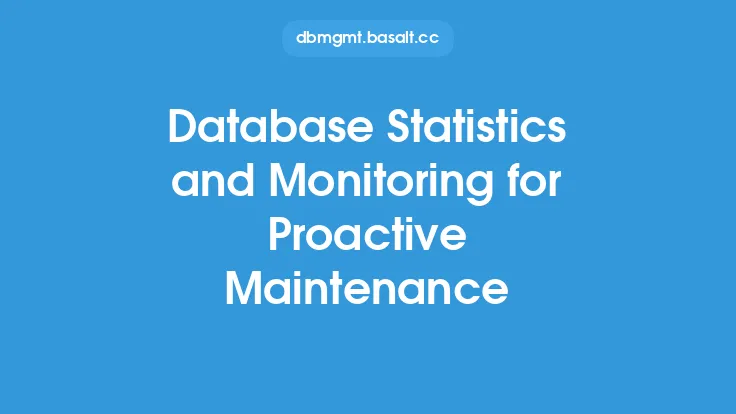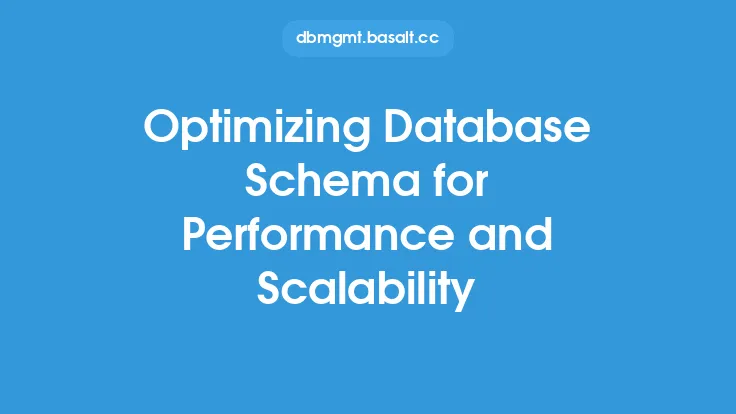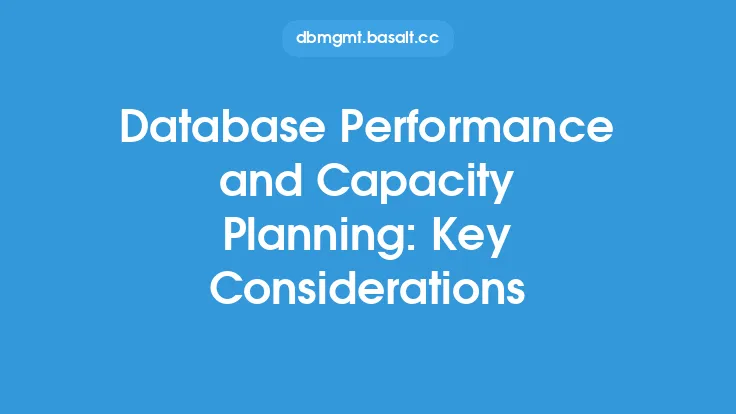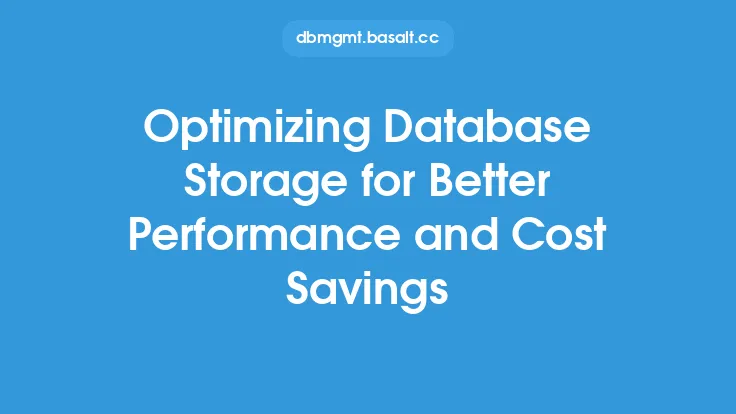Collecting and analyzing database statistics is a crucial step in identifying performance bottlenecks and optimizing database systems. Database statistics provide valuable insights into the performance characteristics of a database, allowing administrators to make informed decisions about indexing, caching, and other optimization techniques. In this article, we will delve into the world of database statistics, exploring the different types of statistics, how to collect them, and how to analyze them for performance improvement.
Introduction to Database Statistics
Database statistics are numerical values that describe the performance characteristics of a database. These statistics can be broadly categorized into two types: internal statistics and external statistics. Internal statistics are collected by the database management system (DBMS) itself and provide information about the database's internal workings, such as the number of rows in a table, the number of indexes on a table, and the amount of disk space used by the database. External statistics, on the other hand, are collected by external tools and provide information about the database's performance from an external perspective, such as the number of queries executed per second, the average response time of queries, and the amount of network traffic generated by the database.
Types of Database Statistics
There are several types of database statistics that can be collected, including:
- Table statistics: These statistics provide information about the physical structure of tables, such as the number of rows, the number of indexes, and the amount of disk space used.
- Index statistics: These statistics provide information about the performance of indexes, such as the number of index scans, the number of index updates, and the average cost of index maintenance.
- Query statistics: These statistics provide information about the performance of queries, such as the number of queries executed, the average response time of queries, and the amount of CPU and disk resources used by queries.
- System statistics: These statistics provide information about the overall performance of the database system, such as the amount of CPU and disk resources used, the amount of memory allocated, and the number of connections established.
Collecting Database Statistics
Collecting database statistics can be done using a variety of tools and techniques, including:
- DBMS-built-in tools: Most DBMSs provide built-in tools for collecting database statistics, such as the `ANALYZE` command in Oracle or the `UPDATE STATISTICS` command in SQL Server.
- Third-party tools: There are many third-party tools available for collecting database statistics, such as database monitoring tools, performance analysis tools, and query optimization tools.
- SQL scripts: Database administrators can also use SQL scripts to collect database statistics, such as querying system views or executing stored procedures.
Analyzing Database Statistics
Analyzing database statistics requires a combination of technical expertise and business acumen. Database administrators must be able to interpret the statistics, identify trends and patterns, and make recommendations for performance improvement. Some common techniques for analyzing database statistics include:
- Trend analysis: This involves analyzing statistics over time to identify trends and patterns in database performance.
- Correlation analysis: This involves analyzing the relationship between different statistics to identify cause-and-effect relationships.
- Benchmarking: This involves comparing database performance to industry benchmarks or internal standards.
Using Database Statistics for Performance Improvement
Database statistics can be used to identify performance bottlenecks and optimize database systems in a variety of ways, including:
- Index optimization: Database statistics can be used to identify indexes that are not being used effectively and to optimize index maintenance.
- Query optimization: Database statistics can be used to identify queries that are not performing well and to optimize query execution plans.
- Resource allocation: Database statistics can be used to identify areas where resource allocation can be improved, such as allocating more CPU or disk resources to the database.
- Capacity planning: Database statistics can be used to identify trends and patterns in database growth and to plan for future capacity needs.
Best Practices for Database Statistics Collection and Analysis
To get the most out of database statistics, database administrators should follow best practices for collection and analysis, including:
- Regularly collecting statistics: Database statistics should be collected regularly to ensure that the database is performing optimally.
- Using automated tools: Automated tools can help to streamline the process of collecting and analyzing database statistics.
- Analyzing statistics in context: Database statistics should be analyzed in the context of the overall database system and business requirements.
- Continuously monitoring performance: Database performance should be continuously monitored to identify areas for improvement.
Common Challenges and Pitfalls
Collecting and analyzing database statistics can be challenging, and there are several common pitfalls to watch out for, including:
- Inaccurate or incomplete statistics: Database statistics may be inaccurate or incomplete if they are not collected regularly or if the collection process is flawed.
- Over-reliance on automation: While automated tools can be helpful, database administrators should not rely solely on automation for collecting and analyzing database statistics.
- Lack of context: Database statistics should be analyzed in the context of the overall database system and business requirements.
- Insufficient resources: Collecting and analyzing database statistics requires sufficient resources, including CPU, disk, and memory.
Conclusion
Collecting and analyzing database statistics is a critical step in identifying performance bottlenecks and optimizing database systems. By understanding the different types of database statistics, how to collect them, and how to analyze them, database administrators can make informed decisions about indexing, caching, and other optimization techniques. By following best practices for collection and analysis and avoiding common pitfalls, database administrators can ensure that their databases are performing optimally and that business requirements are being met.





